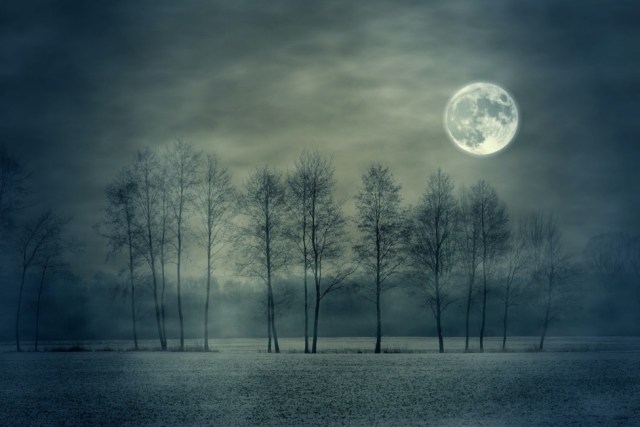Does the moon affect weather? Lunar folklore, moon magic, weather lore and science
5 min read
“Silver-sickled, celestial, circling satellite suspended in star-slung, far-flung skies.
Full-bellied billowing, voluminously glittering, luminously glistering in lunatics’ eyes.
The thrice-spinning moon threads stories through time, spun with the world-wending wisdom of old.
Prophesying poetry: there is magic in words; the weather-witch speaks of secrets foretold.”
Lunar Lore by Kirstin Mills.
Farmers, sailors, and other sky watchers have long used the Moon to predict the weather.
The Zuni Indians thought a red moon brought water, while Seventeenth-century English farmers believed in a “dripping moon” which supplied rain depending on whether its crescent was tilted up or down.
And now scientists have found evidence for another adage: rain follows the full and new phases of the moon!
The poem above was inspired by a little nineteenth-century volume of Weather Folklore, in which the author, introducing a section on lore of the moon, referred to it literally as a “weather witch.”
In fact, the moon too has always had her votaries, as a weather-witch, and even now is not without its prophets ready to assert her influence over the weather, rain and clouds.

There are many familiar folklore proverbs that use the moon’s halo to predict the approach of rain.
A particularly poetic example states:
“If the moon show a silver shield,
Be not afraid to reap your field;
But if she rises haloed round,
Soon we’ll tread on deluged ground.”
From Scotland we have the saying:
“When round the moon there is a bruoh,
the weather will be cold and rough.”
And the beautifully simple:
“The moon with a circle brings water in her beak.”
Moreover, “The further the ‘burr’ or halo appears from the moon, the nearer at hand is the coming rain.”
The idea that a haloed moon foretells rain is actually reflected in modern atmospheric sciences, where the light reflected from the moon is refracted by ice crystals at high altitude, such as when passing through high sirrus clouds, which can be the earliest to appear in an approaching low front.

Popular folklore has long believed that weather patterns are stronger around the new and full moons.
Some include:
• If winter’s new moon has horns sharp and defined, expect frost.
• A new moon with sharp horns threatens windy weather.
• An old moon in a mist, Is worth gold in a kist (chest);
But a new moon’s mist will never lack thirst.
• Clear moon, frost soon.
In any case, The idea that weather changes are more likely to occur around the full and new moons is increasingly supported by science, with some studies recording rain actually following these moon phases.
But there are other ways that folklore and science meet around the full moon. Folklore has long associated the moon’s cycle with the wax and wane of women’s menstrual cycles as, on average, both last 28 days, fertility and pregnancy, and it seems that some scientific investigations have noticed a similar correlation.
It is said that more births are recorded after full moon’s peak than at its wane, as if the swollen lunar belly tugs at the womb, drawing its life outwards, just like the ocean’s tide, while the onset of menstrual bleeding more commonly falls after the moon’s peak.
Also the influence of the moon on psychology and human behaviour was prevalent long before modern investigations began to notice the seeming accuracy of the correlation.
For example, the words “lunacy” and “lunatic” derive from “lunar” and the 1842 Lunacy Act defined a “Lunatic” literally as “a demented person enjoying lucid intervals during the first two phases of the Moon and afflicted with a period of fatuity in the period following after the full Moon.”
Strangely enough, some studies have noted that incidents of violence and murder peak at the full moon.

Though less scientific, the alignment of the moon’s cycle with the calendar has also been used to predict weather and ill omens. Some proverbs include:
“Two full moons in a month bring on a flood“, from Bedfordshire.
“If the moon change on a Sunday, there will be a flood before the month is out“, from Worcestershire.
“Saturday’s change and Sunday’s full
Never brought good and never wull“, from Norfolk
“A Saturday’s change and a Sunday’s full moon,
Once in seven years is once too soon.”
The next time that you look up at the Moon, consider also this weather-related folklore.
See if this holds true where you live…
• In the wane of the Moon, a cloudy morning bodes a fair afternoon.
• If the crescent Moon holds its points upward, able to contain water, it predicts a dry spell.
• If the new Moon stands on its points, expect precipitation to spill out.
• A winter full Moon is a time for long cold snaps.
• A full Moon in April brings frost.
• Two full Moons in a month increase the chances of flood.
• A pale full Moon indicates rain, while a red one brings wind.
• A Christmas full Moon predicts a poor harvest.
• The days following a new Moon or a full Moon are typically stormy.
Moreover, sailors agree that the full Moon “eats clouds.”
Whether completely grounded in science or leaning more to the superstitious, one thing is clear: moon lore and folklore around it are poetic remnants of the past that are well worth cherishing and that we can continue to pass down.

Images from web – Google Research






